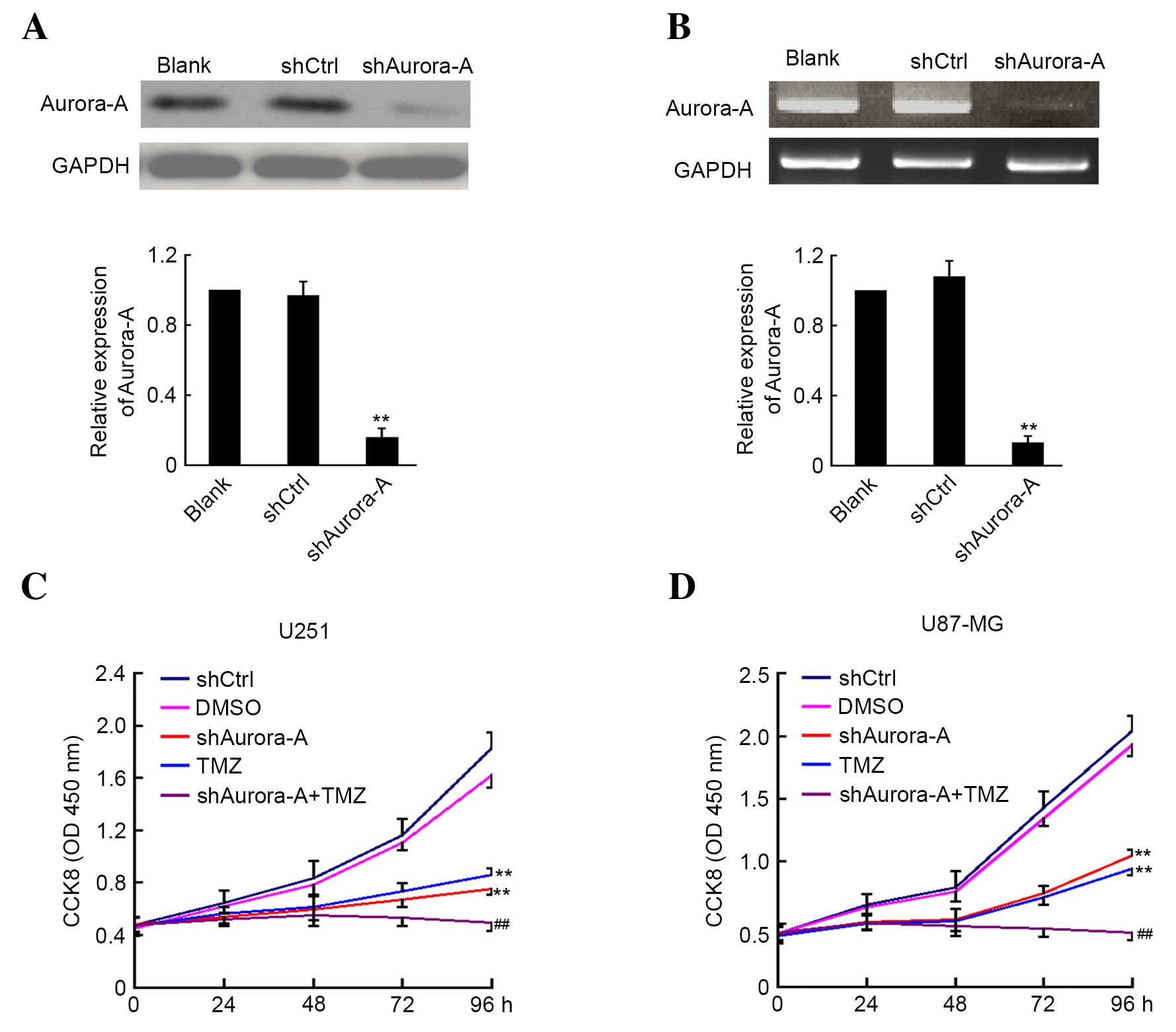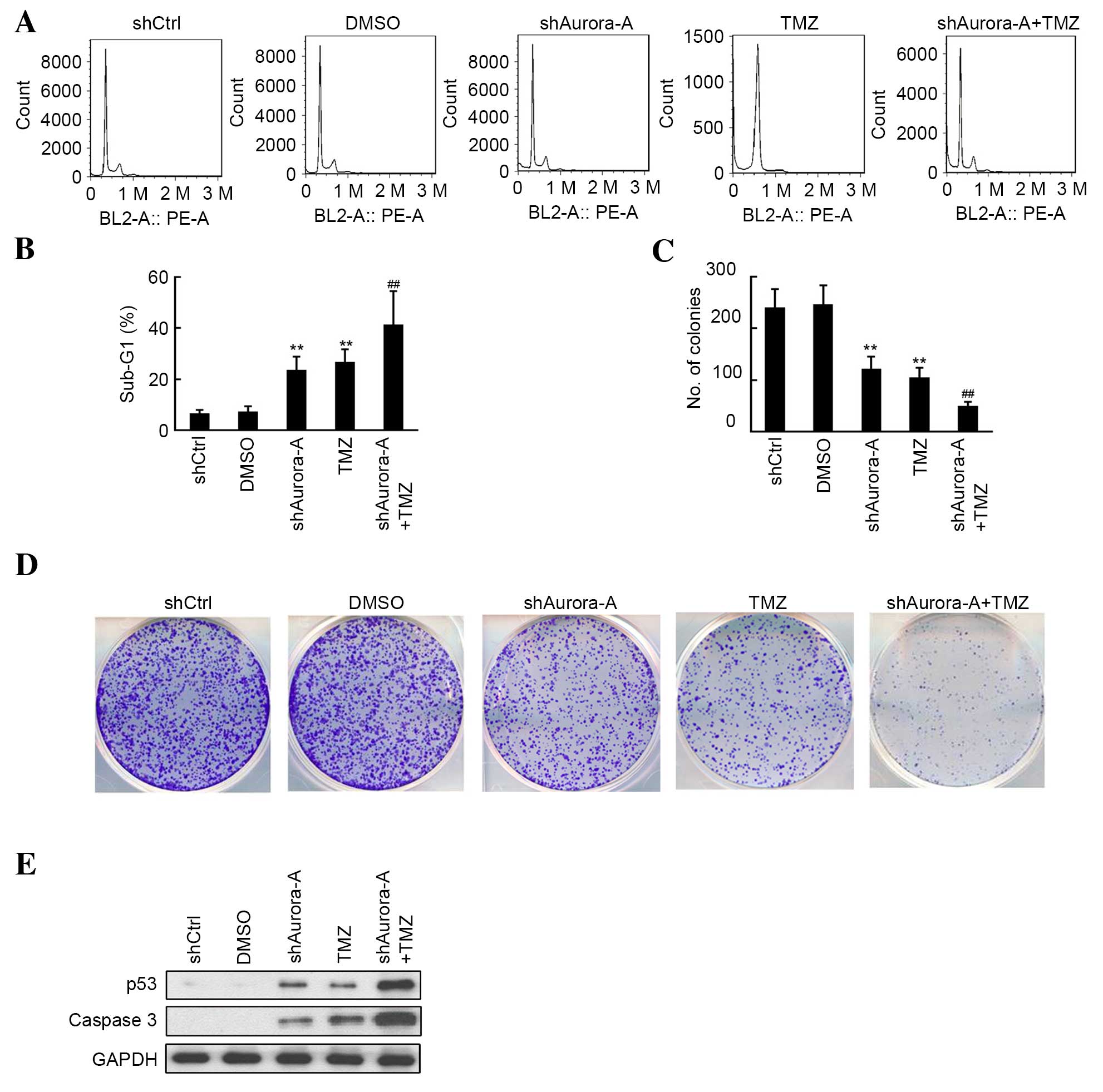|
1
|
Sathornsumetee S and Rich JN: New
treatment strategies for malignant gliomas. Expert Rev Anticancer
Ther. 6:1087–1104. 2006. View Article : Google Scholar : PubMed/NCBI
|
|
2
|
Mrugala MM and Chamberlain MC: Mechanisms
of disease: Temozolomide and glioblastoma-look to the future. Nat
Clin Pract Oncol. 5:476–486. 2008. View Article : Google Scholar : PubMed/NCBI
|
|
3
|
Friedman HS, Kerby T and Calvert H:
Temozolomide and treatment of malignant glioma. Clin Cancer Res.
6:2585–2597. 2000.PubMed/NCBI
|
|
4
|
Osoba D, Brada M, Yung WK and Prados M:
Health-related quality of life in patients treated with
temozolomide versus procarbazine for recurrent glioblastoma
multiforme. J Clin Oncol. 18:1481–1491. 2000.PubMed/NCBI
|
|
5
|
Margison GP, Santibáñez Koref MF and Povey
AC: Mechanisms of carcinogenicity/chemotherapy by O6-methylguanine.
Mutagenesis. 17:483–487. 2002. View Article : Google Scholar : PubMed/NCBI
|
|
6
|
Hirose Y, Berger MS and Pieper RO: p53
effects both the duration of G2/M arrest and the fate of
temozolomide-treated human glioblastoma cells. Cancer Res.
61:1957–1963. 2001.PubMed/NCBI
|
|
7
|
Quiros S, Roos WP and Kaina B: Processing
of O6-methylguanine into DNA double-strand breaks requires two
rounds of replication whereas apoptosis is also induced in
subsequent cell cycles. Cell Cycle. 9:168–178. 2010. View Article : Google Scholar : PubMed/NCBI
|
|
8
|
Ahluwalia MS, Xie H, Dahiya S,
Hashemi-Sadraei N, Schiff D, Fisher PG, Chamberlain MC, Pannullo S,
Newton HB, Brewer C, et al: Efficacy and patient-reported outcomes
with dose-intense temozolomide in patients with newly diagnosed
pure and mixed anaplastic oligodendroglioma: A phase II multicenter
study. J Neurooncol. 122:111–119. 2015. View Article : Google Scholar : PubMed/NCBI
|
|
9
|
Taphoorn MJ, Henriksson R, Bottomley A,
Cloughesy T, Wick W, Mason WP, Saran F, Nishikawa R, Hilton M,
Theodore-Oklota C, et al: Health-Related quality of life in a
randomized phase III study of bevacizumab, temozolomide, and
radiotherapy in newly diagnosed glioblastoma. J Clin Oncol.
33:2166–2175. 2015. View Article : Google Scholar : PubMed/NCBI
|
|
10
|
Marumoto T, Honda S, Hara T, Nitta M,
Hirota T, Kohmura E and Saya H: Aurora-A kinase maintains the
fidelity of early and late mitotic events in HeLa cells. J Biol
Chem. 278:51786–51795. 2003. View Article : Google Scholar : PubMed/NCBI
|
|
11
|
Seki A, Coppinger JA, Jang CY, Yates JR
and Fang G: Bora and the kinase Aurora a cooperatively activate the
kinase Plk1 and control mitotic entry. Science. 320:1655–1658.
2008. View Article : Google Scholar : PubMed/NCBI
|
|
12
|
Zhou H, Kuang J, Zhong L, Kuo WL, Gray JW,
Sahin A, Brinkley BR and Sen S: Tumour amplified kinase STK15/BTAK
induces centrosome amplification, aneuploidy and transformation.
Nature Genet. 20:189–193. 1998. View
Article : Google Scholar : PubMed/NCBI
|
|
13
|
Sen S, Zhou H and White RA: A putative
serine/threonine kinase encoding gene BTAK on chromosome 20q13 is
amplified and overexpressed in human breast cancer cell lines.
Oncogene. 14:2195–2200. 1997. View Article : Google Scholar : PubMed/NCBI
|
|
14
|
Van Brocklyn JR, Wojton J, Meisen WH,
Kellough DA, Ecsedy JA, Kaur B and Lehman NL: Aurora-A inhibition
offers a novel therapy effective against intracranial glioblastoma.
Cancer Res. 74:5364–5370. 2014. View Article : Google Scholar : PubMed/NCBI
|
|
15
|
Yang H, Ou CC, Feldman RI, Nicosia SV,
Kruk PA and Cheng JQ: Aurora-A kinase regulates telomerase activity
through c-Myc in human ovarian and breast epithelial cells. Cancer
Res. 64:463–467. 2004. View Article : Google Scholar : PubMed/NCBI
|
|
16
|
Katayama H, Sasai K, Kawai H, Yuan ZM,
Bondaruk J, Suzuki F, Fujii S, Arlinghaus RB, Czerniak BA and Sen
S: Phosphorylation by aurora kinase A induces Mdm2-mediated
destabilization and inhibition of p53. Nat Genet. 36:55–62. 2004.
View Article : Google Scholar : PubMed/NCBI
|
|
17
|
Qin L, Tong T, Song Y, Xue L, Fan F and
Zhan Q: Aurora-A interacts with Cyclin B1 and enhances its
stability. Cancer Lett. 275:77–85. 2009. View Article : Google Scholar : PubMed/NCBI
|
|
18
|
Sasayama T, Marumoto T, Kunitoku N, Zhang
D, Tamaki N, Kohmura E, Saya H and Hirota T: Over-expression of
Aurora-A targets cytoplasmic polyadenylation element binding
protein and promotes mRNA polyadenylation of Cdk1 and cyclin B1.
Genes Cells. 10:627–638. 2005. View Article : Google Scholar : PubMed/NCBI
|
|
19
|
Yang S, He S, Zhou X, Liu M, Zhu H, Wang
Y, Zhang W, Yan S, Quan L, Bai J and Xu N: Suppression of Aurora-A
oncogenic potential by c-Myc downregulation. Exp Mol Med.
42:759–767. 2010. View Article : Google Scholar : PubMed/NCBI
|
|
20
|
Carol H, Boehm I, Reynolds CP, Kang MH,
Maris JM, Morton CL, Gorlick R, Kolb EA, Keir ST, Wu J, et al:
Efficacy and pharmacokinetic/pharmacodynamic evaluation of the
Aurora kinase A inhibitor MLN8237 against preclinical models of
pediatric cancer. Cancer Chemother Pharmacol. 68:1291–1304. 2011.
View Article : Google Scholar : PubMed/NCBI
|
|
21
|
Huck JJ, Zhang M, McDonald A, Bowman D,
Hoar KM, Stringer B, Ecsedy J, Manfredi MG and Hyer ML: MLN8054, an
inhibitor of Aurora A kinase, induces senescence in human tumor
cells both in vitro and in vivo. Mol Cancer Res. 8:373–384. 2010.
View Article : Google Scholar : PubMed/NCBI
|
|
22
|
Hata T, Furukawa T, Sunamura M, Egawa S,
Motoi F, Ohmura N, Marumoto T, Saya H and Horii A: RNA interference
targeting aurora kinase a suppresses tumor growth and enhances the
taxane chemosensitivity in human pancreatic cancer cells. Cancer
Res. 65:2899–2905. 2005. View Article : Google Scholar : PubMed/NCBI
|
|
23
|
Dai L, Cui X, Zhang X, Cheng L, Liu Y,
Yang Y, Fan P, Wang Q, Lin Y, Zhang J, et al: SARI inhibits
angiogenesis and tumour growth of human colon cancer through
directly targeting ceruloplasmin. Nat Commun. 7:19962016.
View Article : Google Scholar
|
|
24
|
Dai L, Cheng L, Zhang X, Jiang Q, Zhang S,
Wang S, Li Y, Chen X, Du T, Yang Y, et al: Plasmid-based
STAT3-siRNA efficiently inhibits breast tumor growth and metastasis
in mice. Neoplasma. 58:538–547. 2011. View Article : Google Scholar : PubMed/NCBI
|
|
25
|
Wang W, Dai LX, Zhang S, Yang Y, Yan N,
Fan P, Dai L, Tian HW, Cheng L, Zhang XM, et al: Regulation of
epidermal growth factor receptor signaling by plasmid-based
microRNA-7 inhibits human malignant gliomas growth and metastasis
in vivo. Neoplasma. 60:274–283. 2013. View Article : Google Scholar : PubMed/NCBI
|
|
26
|
Cammareri P, Scopelliti A, Todaro M,
Eterno V, Francescangeli F, Moyer MP, Agrusa A, Dieli F, Zeuner A
and Stassi G: Aurora-a is essential for the tumorigenic capacity
and chemoresistance of colorectal cancer stem cells. Cancer Res.
70:4655–4665. 2010. View Article : Google Scholar : PubMed/NCBI
|
|
27
|
Hegi ME, Liu L, Herman JG, Stupp R, Wick
W, Weller M, Mehta MP and Gilbert MR: Correlation of
O6-methylguanine methyltransferase (MGMT) promoter methylation with
clinical outcomes in glioblastoma and clinical strategies to
modulate MGMT activity. J Clin Oncol. 26:4189–4199. 2008.
View Article : Google Scholar : PubMed/NCBI
|
|
28
|
Jiang Z, Pore N, Cerniglia GJ, Mick R,
Georgescu MM, Bernhard EJ, Hahn SM, Gupta AK and Maity A:
Phosphatase and tensin homologue deficiency in glioblastoma confers
resistance to radiation and temozolomide that is reversed by the
protease inhibitor nelfinavir. Cancer Res. 67:4467–4473. 2007.
View Article : Google Scholar : PubMed/NCBI
|
|
29
|
Woo SR, Ham Y, Kang W, Yang H, Kim S, Jin
J, Joo KM and Nam DH: KML001, a telomere-targeting drug, sensitizes
glioblastoma cells to temozolomide chemotherapy and radiotherapy
through DNA damage and apoptosis. Biomed Res Int. 2014:7474152014.
View Article : Google Scholar : PubMed/NCBI
|
|
30
|
Goellner EM, Grimme B, Brown AR, Lin YC,
Wang XH, Sugrue KF, Mitchell L, Trivedi RN, Tang JB and Sobol RW:
Overcoming temozolomide resistance in glioblastoma via dual
inhibition of NAD+ biosynthesis and base excision repair. Cancer
Res. 71:2308–2317. 2011. View Article : Google Scholar : PubMed/NCBI
|
|
31
|
Park I, Mukherjee J, Ito M, Chaumeil MM,
Jalbert LE, Gaensler K, Ronen SM, Nelson SJ and Pieper RO: Changes
in pyruvate metabolism detected by magnetic resonance imaging are
linked to DNA damage and serve as a sensor of temozolomide response
in glioblastoma cells. Cancer Res. 74:7115–7124. 2014. View Article : Google Scholar : PubMed/NCBI
|













